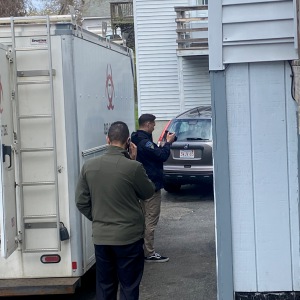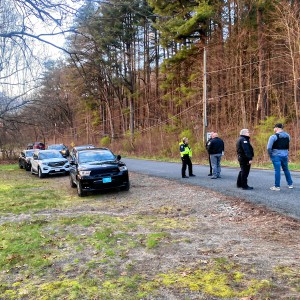Firefighters prep to meet ‘unique challenge’ as electrical vehicles gain popularity
| Published: 03-29-2024 4:23 PM |
Take a drive down Routes 5 and 10 and count the number of electric or hybrid vehicles you see. Compare those numbers to what you saw two years, five years or 10 years ago and you’re likely looking at a significant increase.
Data from the Massachusetts Department of Transportation supports the eye test as well, with 293,712 hybrid and electric passenger and commercial vehicles registered in the state as of Jan. 1 of this year, compared to 130,794 vehicles registered in 2020, which is a roughly 124% increase in four years. Fossil fuel vehicle registrations have remained consistent in that time, with 4.89 million vehicles registered on Jan. 1, compared to 4.901 million in 2020.
In Franklin County specifically, only about 6% of vehicles registered are electric or hybrids, but that number represents a nearly 60% increase since January 2020. Leverett leads the way with approximately 15% of its registered vehicles being electric or hybrid, according to MassDOT.
The trend is growing nationally as well, with the U.S. Energy Information Administration reporting in January that electric and hybrid vehicles accounted for 16.3% of all light-duty vehicle sales in 2023, compared to 12.9% in 2022.
With more electric vehicles on the road, the possibility of electric vehicle fires is also increasing and regional departments have been preparing to meet the “unique challenge” of quelling these lithium-ion battery fires.
“Electric vehicles pose a unique challenge to firefighting. The battery in an electric vehicle is made up of a lot of individual battery cells. When those battery cells are damaged or malfunction they go into what’s called thermal runaway,” said Greenfield Fire Chief Robert Strahan. “That thermal runaway is an event that creates a tremendous amount of smoke and it provides a large fire. When you get multiple cells going, it makes it difficult to put out a lithium-ion fire.”
While departments have been attending statewide training sessions for electric vehicle fires, there are only approximately a dozen each year in Massachusetts, according to the Department of Fire Services. One such training was sponsored by the Deerfield Fire District a few weeks ago at Deerfield Academy, where 54 firefighters got a chance to sit in on presentations and get some hands-on experience looking inside two electric vehicles provided by Ford of Greenfield.
“Electric vehicle fires pose significant safety hazards and suppression challenges for local fire departments. We expect the number will rise as more EVs hit the road, but fortunately we haven’t seen a statistically significant increase in them over the past few years,” said Department of Fire Services spokesperson Jake Wark. “The most recent statistics we have available suggest about 14 or so on average in Massachusetts each year, out of more than 2,000 vehicle fires overall.”
Article continues after...
Yesterday's Most Read Articles
 Authorities ID victim in Greenfield slaying
Authorities ID victim in Greenfield slaying
 State records show Northfield EMS chief’s paramedic license suspended over failure to transport infant
State records show Northfield EMS chief’s paramedic license suspended over failure to transport infant
 Police report details grisly crime scene in Greenfield
Police report details grisly crime scene in Greenfield
 New buyer of Bernardston’s Windmill Motel looks to resell it, attorney says
New buyer of Bernardston’s Windmill Motel looks to resell it, attorney says
 McGovern, Gobi visit development sites in Greenfield, Wendell
McGovern, Gobi visit development sites in Greenfield, Wendell
 High schools: Seventh-inning rally helps Turners Falls softball edge Frontier 6-3 (PHOTOS)
High schools: Seventh-inning rally helps Turners Falls softball edge Frontier 6-3 (PHOTOS)
Lithium-ion batteries are safe, Strahan emphasized, “unless they’re not handled appropriately” or if they are damaged, such as in a crash.
“It’s clear, electric vehicles are the future and they are increasingly showing up all around and are increasingly in motor vehicle accidents,” added Deerfield Fire District Assistant Chief Ben Clark, who noted the battery setup in electric vehicles is different depending on the make and model. “In a standard car you can mitigate a lot of that [risk] by disconnecting the battery. … Unfortunately, there is no standard because it is new technology — every vehicle is different.”
To the knowledge of both Strahan and Clark, there has not been an electric vehicle fire in Franklin County, but with the increased prevalence of these vehicles on the road, “it’s just a matter of time,” according to Strahan.
Battery fires aren’t new — power tools, solar batteries, e-bikes and other lithium-ion-powered equipment can go up in flames, too — but being on the road, and potentially nowhere near a water source, is the biggest challenge due to the amount of water and foam needed to extinguish them, as well as the potential for the fire to reignite.
A typical vehicle fire requires about 1,000 gallons of water — fire engines carry between 500 and 1,000 gallons — while an electric vehicle can take more than 10,000 gallons, or even up to 20,000 gallons, the two local chiefs said.
“You need a water source to extinguish the fire, which in the city is not as complicated because we have hydrants,” Strahan said. “The other issue with the batteries and an electric vehicle is when it starts thermal runaway, it will continue through all the cells. You can go and put the fire out and then within an hour, a day, a week later, the other batteries are going to degrade to the point where they catch fire.”
Additionally, the chemicals present in the batteries create a hazardous materials situation.
“It becomes a scene safety issue there, a hazmat issue,” Clark said. Due to these extra challenges, Clark and Strahan added that departments have had to alter firefighting protocols — which has also extended to towing companies, as they need a steel flatbed to transport electric vehicles — because the vehicles need to be immobilized by removing the key fob to prevent any electrical system failure issues or accidental accelerations.
There is some equipment available to departments, but that creates a financial burden, as it can be expensive. One potential tool are special fire blankets that can envelop the fire, but they are one-time-use only and cost more than $1,000.
Wark, from the Department of Fire Services, explained electric vehicle fire suppression tools have been eligible for the state’s Firefighter Safety Equipment Grants program since 2021 — $5 million was reimbursed this year alone — and there are several federal grant programs available as well.
Training is also always ongoing, and Clark and Strahan said the Department of Fire Services has been extremely effective in working with departments on electric vehicle fire safety.
In terms of fire safety, both local officials and the Department of Fire Services said if you are in an electric vehicle that catches fire, you should pull over, turn the vehicle off, get everyone outside and at least 100 feet away from the vehicle, and then call 911.
“We’re often asked if EV owners should buy any particular safety tools or devices in light of the special hazards that EV fires pose,” Wark said. “Realistically, these fires are beyond the average motorist’s ability to handle.”
Chris Larabee can be reached at clarabee@recorder.com.

 What are the protocols for emergency transport of infants?
What are the protocols for emergency transport of infants? Frontier Regional School students appeal to lower voting age
Frontier Regional School students appeal to lower voting age
